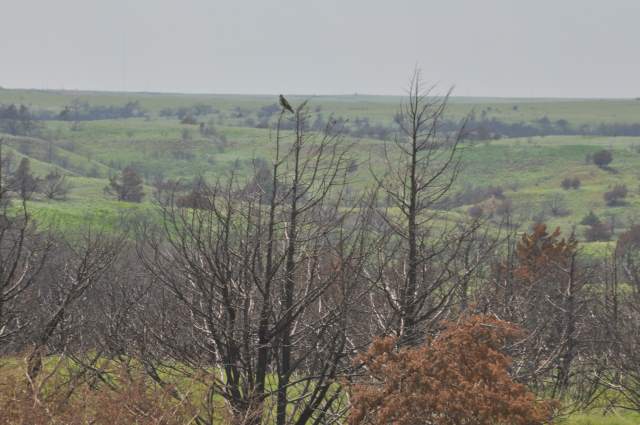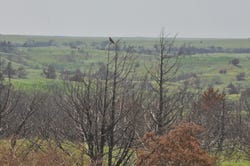
The farm and ranch community in this nation is pretty good about helping one another in hard times, but human nature is such that when hard times fade, we move on, and problems created in the crisis sometimes go unresolved.
The Anderson Creek wildfire in northern Oklahoma and southern Kansas burned more than 600 square miles in March, taking out fences and farm buildings, killing cattle and reportedly burning nine homes. Neighbors helped each other with fence repair/replacement, hay donations for hungry cattle and with rebuilding burned infrastructure. The rains came, time passed, and the land turned green like it always does after a fire.
On a positive note, the wildfire burned thousands upon thousands of Eastern red cedars, many which were too large and/or too deep in canyons to be touched with controlled burns or with equipment. This silver lining is not permanent, however, and the trees will come back from seeds as they always do.
That's just one of the problems a group of ranchers and conservation partners want to address now that the crisis is in the rearview mirror.
The Anderson Creek Wildfire Initiative has a five-point plan to restore the land to a point better than it was before the fire, and the group is looking for financial partners, probably corporate or large non-profit organizations, says Todd Kelly, who is leading the fundraising side of the effort through the Comanche Pool Prairie Resource Foundation. The Comanche Pool is a 501 C-3 non-profit organization formed in 1999 with a mission to regenerate Kansas and northern Oklahoma grazing land resources, so it was a natural umbrella for the Anderson Creek wildfire initiative.
Most of the plans involve cost-share with ranchers and farmers, so everyone has a stake in the outcome.
Ted Alexander, a semi-retired rancher who lives west of Medicine Lodge, Kan., right in the middle of the firescape, and who ranches with his son, Brian, says the mission of the new initiative is to return "ecological functionality" to landscapes unlikely to recover naturally.
He outlined for us the five-step plan:
1. Remove dead, standing invasive tree skeletons
This is a top priority, Alexander says. The dead trees draw birds, which perch on the dead branches, dropping the seeds of not only cedars but other invasive species. The tops of productive ridges will get preference.
2. Restore water resources
Red cedars are a prime focus, since a mature red cedar tree consumes 15 gallons of water per day, Alexander says. Without cedar infestation, that water would be available for native grasses. Clipping small cedar trees and prescribed burning are part of this effort.
3. Restore wildlife habitat
The western edge of the wildfire area borders the eastern edge of the Lesser Prairie Chicken habitat. The degradation of the landscape and invasion of trees has resulted in the bird bring placed on the threatened species list. Alexander believes if the prairie ecology can be restored, the borders of the prairie chicken habitat can be improved and possibly shifted east.
4. Re-establish native grass and forb species
Many of the burn areas, especially those previously under cedar canopy, have problems getting native grasses re-established. The initiative will work to reseed native species of grass and forbs in the burned region.
5. Monitor and control noxious weeds
Noxious weeds seem to have a way of being stronger and recovering faster once they get some open ground, Alexander says. He is worried seeds might come in from donated hay, and says the burned area needs monitoring for such problem areas.

Photo credit: P.J. Griekspoor
The Anderson Creek initiative right now has more than a dozen partners on board, but needs to raise $1 million to provide cost-sharing funds to landowners. Kelly says the short-term goal is to get started on a prioritized 33,000 acres of the more than 400,000 burned.
The U.S. Fish and Wildlife Service estimates that a complete cleanup of the cedar remains and any surviving cedar trees will cost $56 million. Alexander says the full amount is beyond the scope of the initial project, but he thinks once landowners and donors see the program can work, the demand could grow and hopefully the program will grow with it.
If you're interested in contributing, or know someone in the corporate world who might be interesting in helping sponsor this effort, call (620) 213-0133 or email [email protected].
You might also like:
Use cow-pie-ology to monitor your herds nutritional status
5 must-do steps for fly control on cattle
Here's when you should castrate beef valves
9 things to consider before culling a cow
5 tips for preventing, diagnosing & treating foot rot
About the Author(s)
You May Also Like



